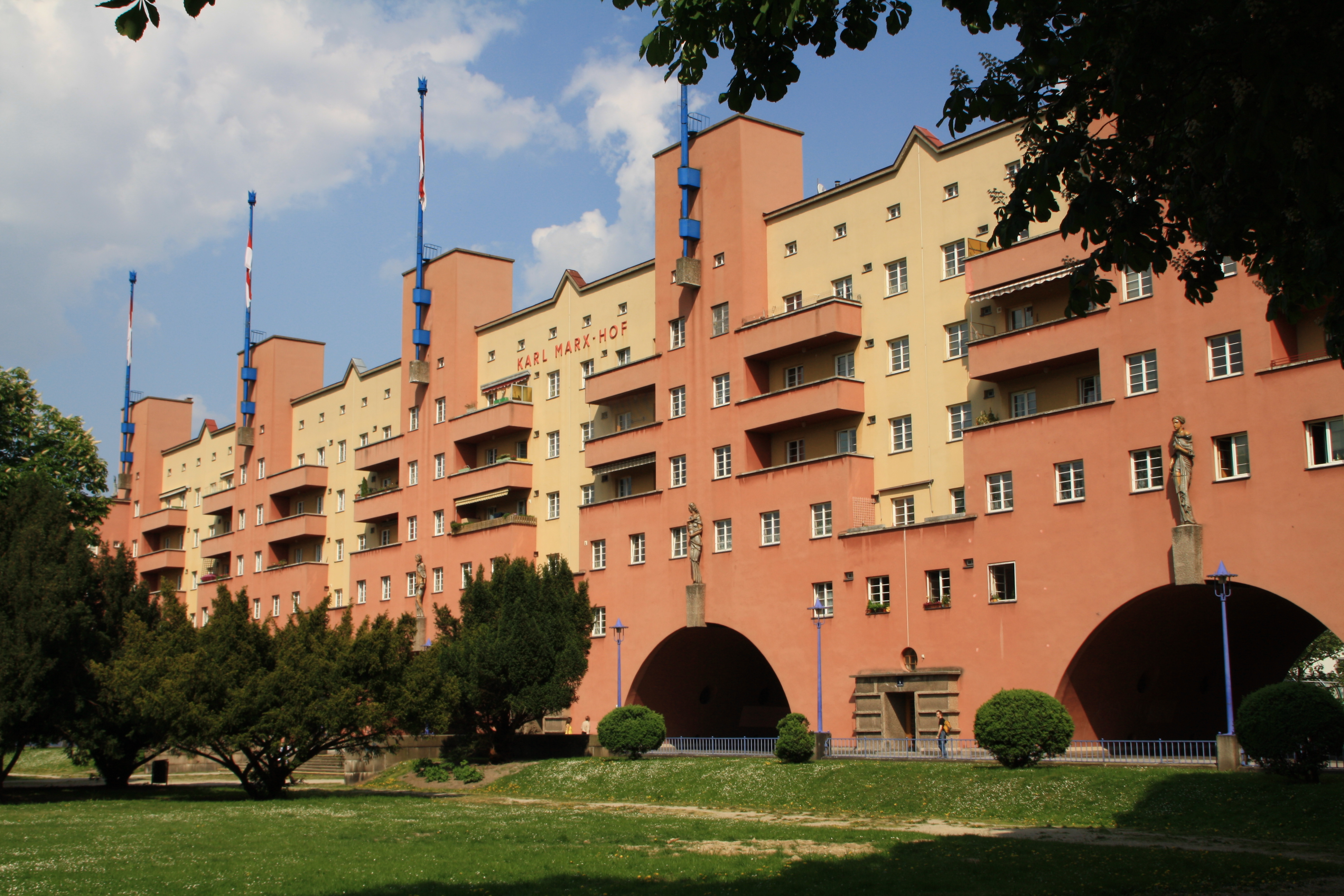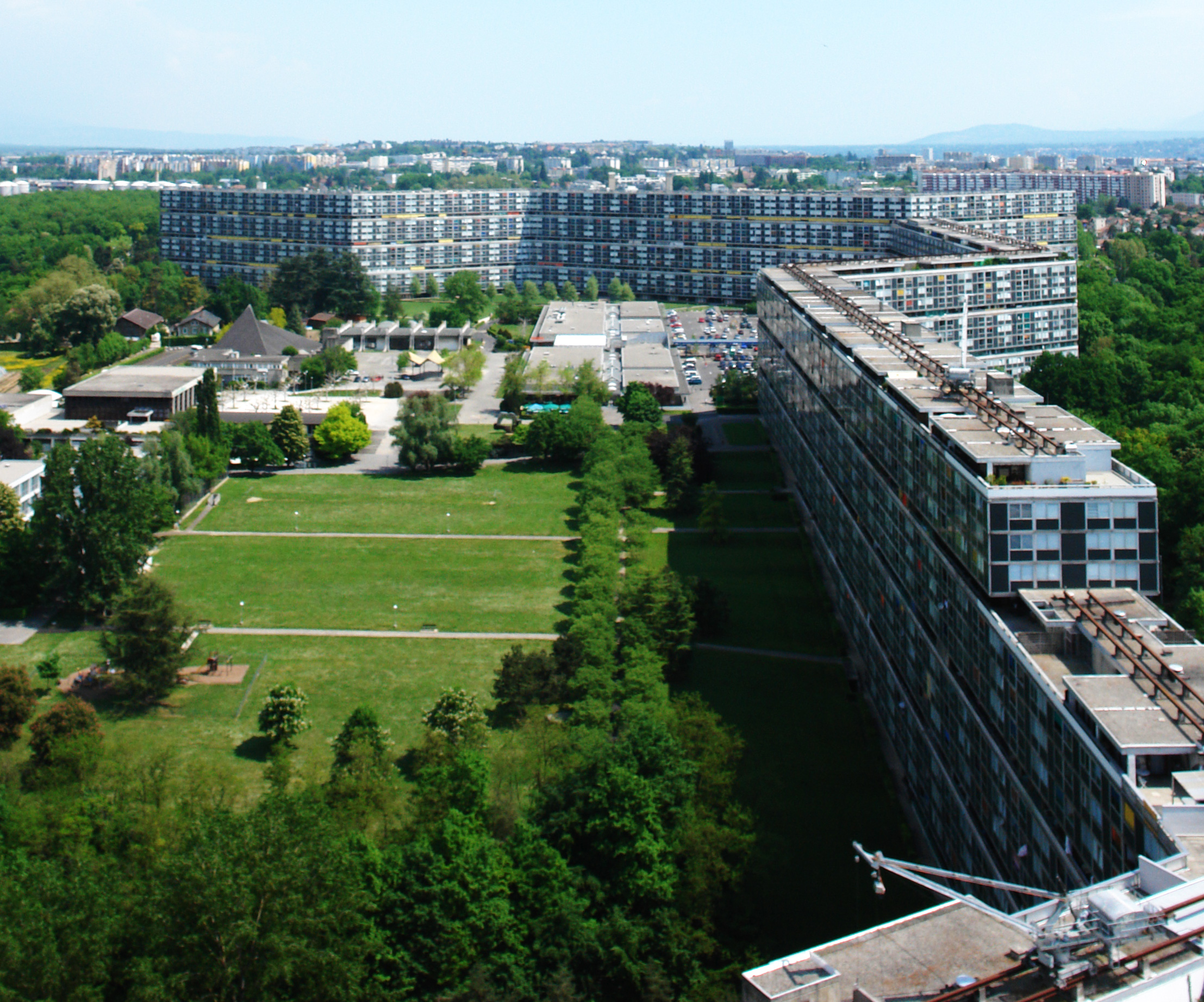|
Karl-Marx-Hof
Karl-Marx-Hof (English: ''Karl Marx Court'') is a ''Gemeindebau'' (English: ''municipal housing complex'') in Vienna, situated in Heiligenstadt, Vienna, Heiligenstadt, a neighbourhood of the 19th district of Vienna, Döbling. At in length and spanning four Trams in Vienna, tram stops, Karl-Marx-Hof is one of the longest single residential buildings in the world. Development Karl-Marx-Hof was built on land that, until the 12th century, had been under the waters of the Danube, deep enough for ships to travel over the area. By 1750, all that remained was a pool of water, which was drained on the order of Holy Roman Emperor Joseph II, Holy Roman Emperor, Joseph II. Gardens were then built in the area, but these were removed by the Vienna city council, then under the "Red Vienna" period of control by the Social Democratic Party of Austria to make room for the erection of Karl-Marx-Hof, financed by a special tax named after councillor Hugo Breitner, commissioning locally and inter ... [...More Info...] [...Related Items...] OR: [Wikipedia] [Google] [Baidu] |
Red Vienna
Red Vienna (German language, German: ''Rotes Wien'') was the colloquial name for the Vienna, capital of Austria between 1918 and 1934, during which the Social Democratic Party of Austria, Social Democratic Workers' Party of Austria (SDAP) maintained near-total political control over Vienna (and for a short time, over First Austrian Republic, Austria as a whole). During this time, the SDAP pursued a rigorous program of construction projects across the city in response to severe housing shortages. This involved implementing policies to improve public education, healthcare, and sanitation, while attempting to create the architectural foundation for a new socialist lifestyle. The collapse of the First Austrian Republic in 1934 Self-elimination of the Austrian Parliament, after the suspension of the ''Nationalrat'' by Engelbert Dollfuss, Engelbert Dollfuß a year earlier, and the subsequent banning of the SDAP in Austria, brought an end to the period of the first socialist project in ... [...More Info...] [...Related Items...] OR: [Wikipedia] [Google] [Baidu] |
Döbling
Döbling () is the 19th Districts of Vienna, district in the city of Vienna, Austria (). It is located in the north of Vienna, north of the districts Alsergrund and Währing. Döbling has some heavily populated urban areas with many residential buildings, and borders the Vienna Woods. Statistik Austria, 2008, website: (in German: population is "Einwohner"). Wien.gv.at webpage (see below: References). It includes some of the most expensive residential areas such as Grinzing, Sievering, and Neustift am Walde, and is home to many ''Heurigen'' taverns. There are some large ''Gemeindebauten'', including Vienna's most famous, the Karl-Marx-Hof. Geography Location Döbling is located in the northwest of Vienna and spans the slope of the Vienna Woods, Wienerwald (Vienna Woods) to the Danube and the Danube Canal, ''Donaukanal'' () that make up the border of the district in the east. The Danube forms the border between Döbling and the district Floridsdorf, and the Canal forms the bo ... [...More Info...] [...Related Items...] OR: [Wikipedia] [Google] [Baidu] |
Gemeindebau
''Gemeindebau'' (; plural: ''Gemeindebauten'') is an Austrian German word for "municipality building".''Gemeinde'' an ''Bau'' in Wiktionary. It refers to residential buildings erected by a municipality in Austria, especially the city of , usually to provide , as an example of . Apartments in the building can be rented from the respective ... [...More Info...] [...Related Items...] OR: [Wikipedia] [Google] [Baidu] |
Heiligenstadt, Vienna
Heiligenstadt (in German language, German: ''Wien Heiligenstadt''; Central Bavarian: ''Heiligenstod'') was an independent Municipality (Austria), municipality until 1892 and is today a part of Döbling, the 19th district of Vienna, Austria. Wien.gv.at webpage (see below: References). Heiligenstadt is one of the 10 municipalities in the Döbling District. Geography Heiligenstadt lies on flat land abutting the Donaukanal, Danube canal and forms a thin strip that stretches to the north-west as far as Leopoldsberg. The municipality covers an area of 219.46 hectares, bordering in the north on Nußdorf, Vienna, Nußdorf and Josefsdorf, in the west on Grinzing, and in the south on Unterdöbling and Oberdöbling. The Probusgasse was once the main street of the village of Heiligenstadt and today marks the centre of the municipality. History The origin of the name Heiligenstadt The name Heiligenstadt (Holy city) suggests that there was already a holy site in this area before the ar ... [...More Info...] [...Related Items...] OR: [Wikipedia] [Google] [Baidu] |
Vienna
Vienna ( ; ; ) is the capital city, capital, List of largest cities in Austria, most populous city, and one of Federal states of Austria, nine federal states of Austria. It is Austria's primate city, with just over two million inhabitants. Its larger metropolitan area has a population of nearly 2.9 million, representing nearly one-third of the country's population. Vienna is the Culture of Austria, cultural, Economy of Austria, economic, and Politics of Austria, political center of the country, the List of cities in the European Union by population within city limits, fifth-largest city by population in the European Union, and the most-populous of the List of cities and towns on the river Danube, cities on the river Danube. The city lies on the eastern edge of the Vienna Woods (''Wienerwald''), the northeasternmost foothills of the Alps, that separate Vienna from the more western parts of Austria, at the transition to the Pannonian Basin. It sits on the Danube, and is ... [...More Info...] [...Related Items...] OR: [Wikipedia] [Google] [Baidu] |
Karl Ehn
Karl Ehn (1 November 1884 – 26 July 1957) was a Viennese architect and city planner. Biography Ehn apprenticed under Otto Wagner, began working for the Vienna City Administration in 1908, and as City Architect of Vienna was responsible for many ''Gemeindebau'' (public housing projects) of the 1920s and 1930s.Architecture in Austria : a Survey of the 20th Century, edited by Sasha Pirker and the Architektur Zentrum Wien, page 66 It is estimated that Ehn designed a total of 2,716 flats during his career. Initially his designs were informed by the English Garden City movement as shown by his early commission at Hermewiese (1923). His most notable single design remains the colossal Karl Marx-Hof (1926-1930), the largest and best example of innovative public housing built during the Socialist Red Vienna movement. According to Joseph Rykwert, Ehn continued to serve the city through the Anschluss The (, or , ), also known as the (, ), was the annexation of ... [...More Info...] [...Related Items...] OR: [Wikipedia] [Google] [Baidu] |
Austrian Civil War
The Austrian Civil War () of 12–15 February 1934, also known as the February Uprising () or the February Fights (), was a series of clashes in the First Austrian Republic between the forces of the authoritarian Fatherland Front (Austria), right-wing government of Engelbert Dollfuss and the Republikanischer Schutzbund, Republican Protection League (), the banned paramilitary arm of the Social Democratic Workers' Party of Austria. The fighting started when League members fired on the Austrian police who were attempting to enter the Social Democrats' party headquarters in Linz to search for weapons. It spread from there to Vienna and other industrial centres in eastern and central Austria. The superior numbers and firepower of the Austrian police and Austrian Armed Forces, Federal Army quickly put an end to the uprising. The overall death toll is estimated at 350. The socialists' defeat led to arrests, executions and the banning of the Social Democratic Party. In May 1934, Austri ... [...More Info...] [...Related Items...] OR: [Wikipedia] [Google] [Baidu] |
Park Hill, Sheffield
Park Hill is a housing estate in Sheffield, South Yorkshire, England. It was built between 1957 and 1961, and in 1998 was given Grade II* listed building status. Following a period of decline, the estate is being renovated by developers Urban Splash into a mostly private mixed-tenure estate made up of homes for market rent, private sale, shared ownership, and student housing while around a quarter of the units in the development will be social housing. The renovation was shortlisted for both the 2013 and 2024 RIBA Stirling Prize, for the first and second phases of the redevelopment respectively. The Estate falls within the Manor Castle ward of the City. Park Hill is also the name of the area in which the flats are sited. The name relates to the deer park attached to Sheffield Manor Lodge, the remnant of which is now known as Arbourthorne, Norfolk Park. History Park Hill was previously the site of Back-to-back houses, back-to-back housing, a mixture of 2–3-storey Tenement, ten ... [...More Info...] [...Related Items...] OR: [Wikipedia] [Google] [Baidu] |
The Night Porter
''The Night Porter'' () is a 1974 Italian erotic psychological war drama film co-written and directed by Liliana Cavani. It stars Dirk Bogarde and Charlotte Rampling, with Philippe Leroy, Gabriele Ferzetti and Isa Miranda in supporting roles. Set in Vienna in 1957, the film centers on the sadomasochistic relationship between a former Nazi concentration camp officer (Bogarde) and one of his inmates (Rampling). The film's themes of sexual and sadomasochistic obsession, and its use of Holocaust imagery, have made the film controversial since its initial release, dividing critics over its artistic value. In July 2018, it was selected to be screened in the Venice Classics section of the 75th Venice International Film Festival. Plot During World War II, Maximilian Theo Aldorfer, a Nazi SS officer who posed as a doctor to take sensational photographs in concentration camps, and Lucia, a teenage girl interned in one such camp due to her father's socialist political ties, had an ambi ... [...More Info...] [...Related Items...] OR: [Wikipedia] [Google] [Baidu] |
Falowiec
Falowiec (plural: ''falowce''; from the Polish word ''fala'', wave) is a block of flats characterised by its length and wavy shape. This type of building was built in Poland in the late 1960s and 1970s in the city of Gdańsk, where there are eight buildings of this type. It is an example of post-war modernism in the PRL. The best-known falowiec in Gdańsk, located at the Obrońców Wybrzeża street, is the second longest housing block in Europe. It has: *11 stories (10 plus the ground floor) *nearly 6,000 occupants *1,792 flats *a length of around It was featured in the 5th episode of ''The Amazing Race 23'' as part of a roadblock. References Similar developments * Byker Wall, Newcastle upon Tyne, UK *, Rome, Italy *Prora, Rügen, Germany *Park Hill, Sheffield Park Hill is a housing estate in Sheffield, South Yorkshire, England. It was built between 1957 and 1961, and in 1998 was given Grade II* listed building status. Following a period of decline, the estate is bei ... [...More Info...] [...Related Items...] OR: [Wikipedia] [Google] [Baidu] |
Fermont
Fermont (; ) is a mining city in Côte-Nord region, Quebec, Canada, near the Quebec-Labrador border about from Labrador City on Route 389, which connects to the Trans-Labrador Highway (Newfoundland and Labrador Route 500). It is the seat of the Regional County Municipality of Caniapiscau. The city is located about 565 km (351 mi) from Baie-Comeau, about 867 km (539 mi) from Saguenay, and about 1,000 km (621 mi) from Quebec City. Fermont (French contraction of "''Fer Mont''", meaning "Iron Mountain") was founded as a company town in the early 1970s to exploit rich iron ore deposits from Mont Wright, which is about to the west. The town is notable for the huge self-contained structure containing apartments, stores, schools, bars, a hotel, restaurants, a supermarket and swimming pool; the large building shelters a community of smaller apartment buildings and homes on its leeward side. Popularly known as The Wall (''Le Mur''), the structure was designed to be a windscree ... [...More Info...] [...Related Items...] OR: [Wikipedia] [Google] [Baidu] |
Le Lignon
Le Lignon is an urban development in the town of Vernier, Switzerland, Vernier, canton of Geneva, Switzerland. It was designed by architect Georges Addor between 1964 and 1966 and consists of three large buildings and is one of the largest apartment complexes in the world, containing 2,780 units. It is located on former farmland and was built to address a housing shortage in the 1960s and early 1970s. It houses over 6,000 residents and of floor space, including a school and a medical center. It makes up a significant portion of the population of Vernier, a town of only some 34,000 residents. With an area of , the population density rivals that of the island of Manhattan. In the 2010s, the building went through a thermal insulation retrofit to improve performance. It is also one of the tallest buildings in Geneva at , surpassed by the Pictet Tower opening in 2026. See also *Bijlmermeer References {{Coord, 46.2031, N, 6.0978, E, source:wikidata, display=title Urban p ... [...More Info...] [...Related Items...] OR: [Wikipedia] [Google] [Baidu] |





